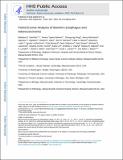| dc.contributor.author | Stachler, Matthew D | |
| dc.contributor.author | Taylor-Weiner, Amaro | |
| dc.contributor.author | Peng, Shouyong | |
| dc.contributor.author | McKenna, Aaron | |
| dc.contributor.author | Agoston, Agoston T | |
| dc.contributor.author | Odze, Robert D | |
| dc.contributor.author | Davison, Jon M | |
| dc.contributor.author | Nason, Katie S | |
| dc.contributor.author | Loda, Massimo | |
| dc.contributor.author | Leshchiner, Ignaty | |
| dc.contributor.author | Stewart, Chip | |
| dc.contributor.author | Stojanov, Petar | |
| dc.contributor.author | Seepo, Sara | |
| dc.contributor.author | Lawrence, Michael S | |
| dc.contributor.author | Ferrer-Torres, Daysha | |
| dc.contributor.author | Lin, Jules | |
| dc.contributor.author | Chang, Andrew C | |
| dc.contributor.author | Gabriel, Stacey B | |
| dc.contributor.author | Beer, David G | |
| dc.contributor.author | Getz, Gad | |
| dc.contributor.author | Carter, Scott L | |
| dc.contributor.author | Bass, Adam J | |
| dc.contributor.author | Lander, Eric Steven | |
| dc.date.accessioned | 2017-01-23T19:22:26Z | |
| dc.date.available | 2017-01-23T19:22:26Z | |
| dc.date.issued | 2015-07 | |
| dc.date.submitted | 2015-02 | |
| dc.identifier.issn | 1061-4036 | |
| dc.identifier.issn | 1546-1718 | |
| dc.identifier.uri | http://hdl.handle.net/1721.1/106589 | |
| dc.description.abstract | Barrett's esophagus is thought to progress to esophageal adenocarcinoma (EAC) through a stepwise progression with loss of CDKN2A followed by TP53 inactivation and aneuploidy. Here we present whole-exome sequencing from 25 pairs of EAC and Barrett's esophagus and from 5 patients whose Barrett's esophagus and tumor were extensively sampled. Our analysis showed that oncogene amplification typically occurred as a late event and that TP53 mutations often occurred early in Barrett's esophagus progression, including in non-dysplastic epithelium. Reanalysis of additional EAC exome data showed that the majority (62.5%) of EACs emerged following genome doubling and that tumors with genomic doubling had different patterns of genomic alterations, with more frequent oncogenic amplification and less frequent inactivation of tumor suppressors, including CDKN2A. These data suggest that many EACs emerge not through the gradual accumulation of tumor-suppressor alterations but rather through a more direct path whereby a TP53-mutant cell undergoes genome doubling, followed by the acquisition of oncogenic amplifications. | en_US |
| dc.description.sponsorship | National Human Genome Research Institute (U.S.) Large-Scale Sequencing Program (Grant U54 HG0003067) | en_US |
| dc.language.iso | en_US | |
| dc.publisher | Nature Publishing Group | en_US |
| dc.relation.isversionof | http://dx.doi.org/10.1038/ng.3343 | en_US |
| dc.rights | Creative Commons Attribution-Noncommercial-Share Alike | en_US |
| dc.rights.uri | http://creativecommons.org/licenses/by-nc-sa/4.0/ | en_US |
| dc.source | PMC | en_US |
| dc.title | Paired exome analysis of Barrett's esophagus and adenocarcinoma | en_US |
| dc.type | Article | en_US |
| dc.identifier.citation | Stachler, Matthew D et al. “Paired Exome Analysis of Barrett’s Esophagus and Adenocarcinoma.” Nature Genetics 47.9 (2015): 1047–1055. | en_US |
| dc.contributor.department | Massachusetts Institute of Technology. Department of Biology | en_US |
| dc.contributor.mitauthor | Lander, Eric Steven | |
| dc.relation.journal | Nature Genetics | en_US |
| dc.eprint.version | Author's final manuscript | en_US |
| dc.type.uri | http://purl.org/eprint/type/JournalArticle | en_US |
| eprint.status | http://purl.org/eprint/status/PeerReviewed | en_US |
| dspace.orderedauthors | Stachler, Matthew D; Taylor-Weiner, Amaro; Peng, Shouyong; McKenna, Aaron; Agoston, Agoston T; Odze, Robert D; Davison, Jon M; Nason, Katie S; Loda, Massimo; Leshchiner, Ignaty; Stewart, Chip; Stojanov, Petar; Seepo, Sara; Lawrence, Michael S; Ferrer-Torres, Daysha; Lin, Jules; Chang, Andrew C; Gabriel, Stacey B; Lander, Eric S; Beer, David G; Getz, Gad; Carter, Scott L; Bass, Adam J | en_US |
| dspace.embargo.terms | N | en_US |
| mit.license | OPEN_ACCESS_POLICY | en_US |
